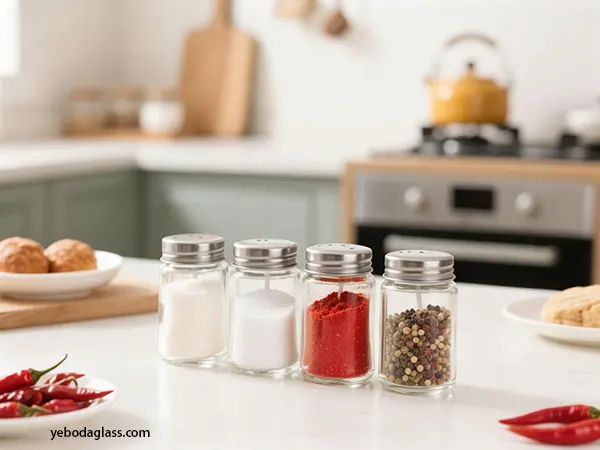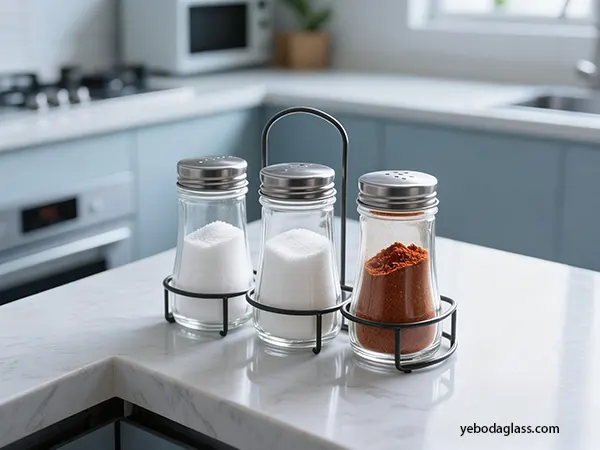Introduction
In today’s competitive market, establishing a separate brand identity is paramount for success, especially within the food industry. Custom seasoning jars provide a powerful and tangible avenue to convey their unique price offers for brands, connect with target consumers at emotional levels and to separate themselves from competitors. This report examines strategic importance of seasoning jars in creating a strong brand identity, covers industry analysis, discovered methods of measuring targeted demographic profiling, visual language translation, perceived price alignment, functional design, competitive discrimination, prototypeings, supply chain ideas and brand effects. By taking advantage of innovative design, permanent glass containers and thoughtful functionality, custom seasoning jars can serve as powerful brand assets, promote loyalty and run business objectives. For example, Oui, oui.‘s seasoning jars are recognized for their durability, elegant design and airtight sealing performance, which not only preserves freshness, but also strengthens a premium brand image.

Industry and Product Category Analysis
Spice market is characterized by unique taste, health-conscious options and increasing consumer interest in authentic culinary experiences. Packaging, especially the custom seasoning jars, plays an important role in expressing these characteristics. For example, brands focusing on artisans or special products can take advantage of glass seasoning jars to convey craftsmanship and premium quality. Visual appeal of a glass bottle or glass jar, the choice of material and functional design can immediately indicate whether no brand aligns with values such as health and commitment to welfare, stability, or moral source.
Market trends indicate a strong preference for packaging that is not only aesthetically pleasing, but also functional and durable. Consumers are rapidly investigating packaging for its environmental impact, with the increasing desire to pay premiums for products in environmentally friendly or reusable glass containers. It presents the opportunity for brands to distinguish their packaging options by adopting permanent material and transparent communication about their packaging options. In addition, the demand for ethnic taste and regional mixtures is increasing, causing the requirement of seasoning jars that can represent the origin and character of these spices.
Target Demographic and Psychological Outline
Importance of Consumer Understanding
Understanding the goal demographic and their psychological profile is important for designing the custom spice jar that resonates. Psychological division moves beyond the basic demographics to detect the values, beliefs, attitudes, interests, lifestyle and personality symptoms of consumers. For the food industry, this means understanding the consumers’ perspectives towards health, stability, culinary exploration, and home entertainment.
Psychological Variable
The major psychological variables include lifestyle (hobbies, social activities), personality symptoms (eg, environmental consciousness, social responsibility), and aspirations. For example, health-conscious consumers prioritize organic, natural or plant-based products, and their procurement decisions are often affected by health benefits and moral ideas. Artisan food consumers are designed for new and exciting features, which is a primary driver with taste, but also appreciate products that provide a unique experience.
Data Collection Methods
Methods of collecting psychological data include customer survey, interviews, focus groups, social media monitoring and web analytics. This data can be used to create a wide buyer personality, which are ideal customers’ imaginary profiles that guide marketing and product development strategies. Understanding these psychological nuances, the brands can tailor your glass seasoning jars packaging design, messages and overall brand experience to create an intensive emotional relationship with their goal audience.
Value and Price Point Alignment
The design of the custom seasoning jars directly communicates the desired price point and the alleged value of the seasoning. Consumers often use packaging as a request for quality, combining high value points with better products. Therefore, packaging must align with market expectations and brand status. Premium packaging design, using high quality materials, refined finish, and elaborately paying attention, can increase the perceived price of a product. For example, elements such as Embossing, Debossing, Soft-Tech Finnish, and metallic foil are commonly used to express specificity and quality by luxury brands. In contrast, minimal packaging with clear branding and strong typography can also indicate a high-end, sophisticated product, suggesting that the underlying quality of the product is not required to be detailed. The choice between minimum and maximalist design can also affect the perceived value. Minimum designs are often echoed with consumers that combine simplicity with quality, authenticity and stability. However, detailed packaging can be favored in luxury markets, where “unboxing”

Functional Design Integration & Material Innovation
Beyond aesthetics, the functional design of the custom spice jar is important for the perception of the user experience and brand. Seasoning containers should be airtight and provide adequate barrier protection to preserve moisture, temperature ups and downs, and taste, aroma and spices quality. Resealable closures are important to maintain consumer convenience and product integrity.
New Remittance System
Innovative dispensing mechanism can greatly increase the purpose and separate a brand. These include twist-end-dispenses lids for the release of spices, integrated measuring dispenser for the exact part, and even smart dispenser with AI abilities for individual spices suggestions.
Ergonomics and Purpose
Ergonomic ideas are also important, ensuring that the glass is comfortable to catch the glass jar, easy to open, and safe to use, especially for consumers with different -different physical abilities. Features such as easy-gray surfaces, intuitive opening mechanisms, and well-distributed weight can reduce physical stress and prevent injuries.
Innovation for Seasoning Jars
Material innovation plays an important role in both functionality and stability. While glass bottles remain a preferred material for their inaction, reusable, and premium perception, plant-based plastic (PLA, PHA), maritime algae-based films, and progress in permanent ingredients such as masalium offers eco-friendly options. The choice of materials should also be considered on its impact on the product’s shelf life and the ability to protect it from UV light, which can make the essential oils down.
Competitive Landscape & Differentiation Strategies
In a crowded spice market, custom packaging is a primary tool for discrimination. Brands should analyze how competitive market attention is using seasoning jars to catch market attention and identify opportunities for unique design solutions.
Stability As A Discrimination
Sustainability is a major discrimination, in which brands adopt environmentally friendly materials such as paper tubes, biodegradable pouches and recycled glass containers. Companies such as the Ganis Spice have demonstrated success by focusing on the refusal glass spice jar system, preventing significant amounts of waste.
Adaptation and Unique Design
Adaptation in terms of unique shapes, colors, materials and graphics is important to establish a separate brand identity. Innovative approaches include offering a spice grinder with a custom label, creating a sample set with a test tube, and using transparent glass bottles to demonstrate the quality of the product.
Intégration technologique
The use of QR code can increase customer engagement by adding recipe ideas or culinary tips. In addition, brands can differentiate by highlighting unique sales proposals such as natural ingredients, rare masala mixtures, or a strong commitment for production chain transparency.

Custom Glass Jar Design Concepts & Prototype Path
Strategic designs and prototypes are required to develop a custom spice jar, balanceing beauty appeals, functional needs and manufacturing viability. The process usually begins with detailed technical images and intense understanding of user needs and potential pain points.
Prototyping Approaches
The prototype allows for the verification of testing and design concepts on hands before committing to mass production. The approach includes digital rendering, 3D models, physical mockups and small-batch glass molding. 3D printing can be used to create molds or to create detailed prototypes for functional testing.
Por que os potes de vidro para mel são os preferidos para embalagens de exportação?
outubro 1, 2025
Os frascos de vidro para mel garantem a segurança alimentar, prolongam a vida útil dos produtos e aumentam o apelo premium da sua marca, além de contribuírem para a sustentabilidade na exportação global.
O mel, um produto comercializado globalmente, exige embalagens que preservem suas qualidades únicas e atendam aos padrões internacionais. Nesse cenário complexo, os potes de vidro para mel surgiram como a solução de embalagem preferida para exportações frequentes. Os potes de vidro para mel da
O vidro oferece durabilidade superior, apelo estético e designs adaptáveis, aprimorando o valor da marca e a percepção do consumidor. Este relatório examina as razões multifacetadas por trás da predominância do vidro, analisando os principais fatores que elevam sua prioridade sobre outras opções. Ele oferece uma compreensão abrangente de por que os potes de vidro para mel continuam sendo o padrão ouro para embalagens de exportação de mel por meio de análise comparativa, uma abordagem com as partes interessadas, estudos de impacto regional e avaliações econômicas e ambientais. O relatório fornece uma análise detalhada e especializada da física, da dinâmica do mercado e das estruturas regulatórias que moldam as decisões internacionais sobre embalagens de mel.
Análise comparativa de embalagens de vidro versus materiais alternativos para exportação de mel.
A escolha dos materiais de embalagem para exportação de mel exige rigor na integridade do produto, na capacidade de comercialização e na eficiência lógica. Embora existam diversos materiais disponíveis,
- Apresentam desempenho consistentemente superior às opções em diversas matrizes importantes. Esta seção descreve uma análise comparativa de pote de vidro para mel
- Em comparação com as opções comuns: plástico (PET, HDPE), metal (folha de flandres) e embalagem flexível. Embalagem de vidro
- Inércia: O vidro é quimicamente passivo, evitando reações com o mel ou lixiviação, mantendo assim a pureza, o sabor e o perfil nutricional em níveis fundamentais, especialmente para o mel cru ou orgânico.
- Os recipientes de vidro oferecem uma vedação completa contra gases, umidade e odores, prevenindo a oxidação, alterações de umidade e contaminação, o que aumenta consideravelmente a vida útil do produto. A transparência do vidro permite que os consumidores observem o produto, sua cor natural, estabilidade e qualquer cristalização, o que geralmente indica a qualidade do mel cru.

O vidro expressa qualidade, tradição e um toque de luxo, aumentando o valor atribuído ao mel.
- Recrutamento: O vidro é 100% reciclado e pode ser reutilizado infinitamente sem perda de qualidade, sendo uma opção altamente durável onde a infraestrutura necessária já existe.
- Resistência e segurança: Oferece excelente proteção contra danos físicos e assédio.
- Eye-tracking studies: O vidro é muito mais pesado do que o plástico ou as embalagens flexíveis, o que acarreta custos de envio elevados e aumenta a pegada de carbono durante o transporte.
- Caro: O vidro é suscetível a quebras, o que exige embalagens secundárias resistentes e manuseio cuidadoso, aumentando o custo e a complexidade lógica.
Consumo de energia:
A produção de vidro novo consome muita energia, embora esse consumo seja reduzido pelas altas taxas de reciclagem.
Conclusion
O PET é um plástico comum usado para embalagens de alimentos, incluindo alguns produtos à base de mel, especialmente no mercado interno ou para grandes quantidades.




